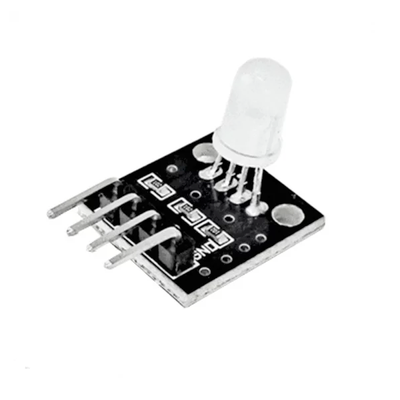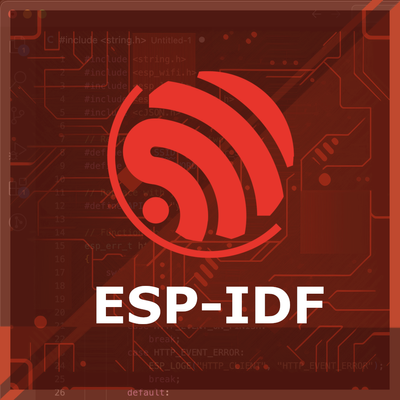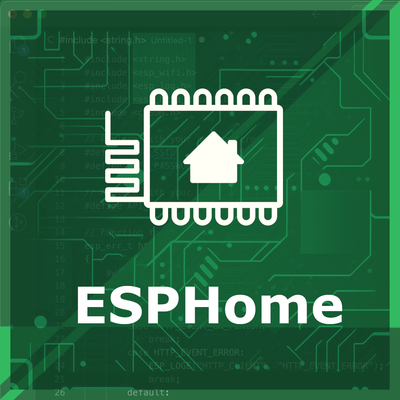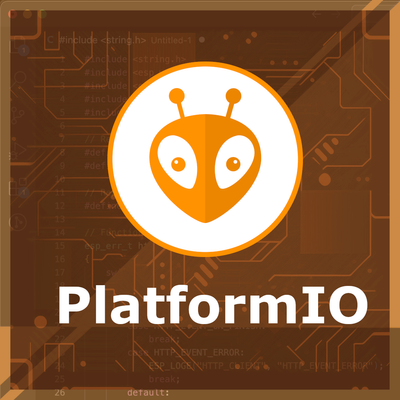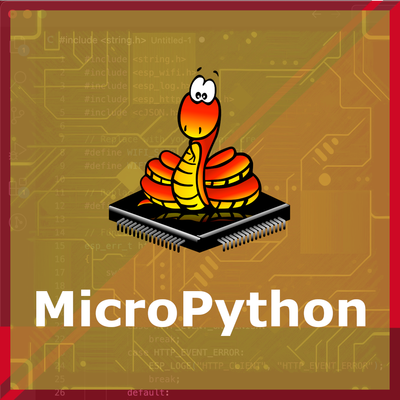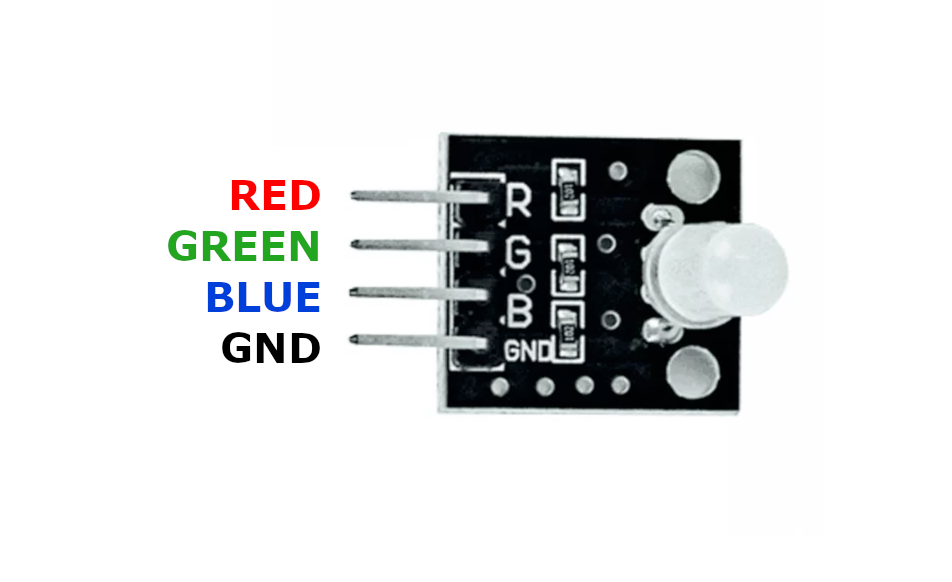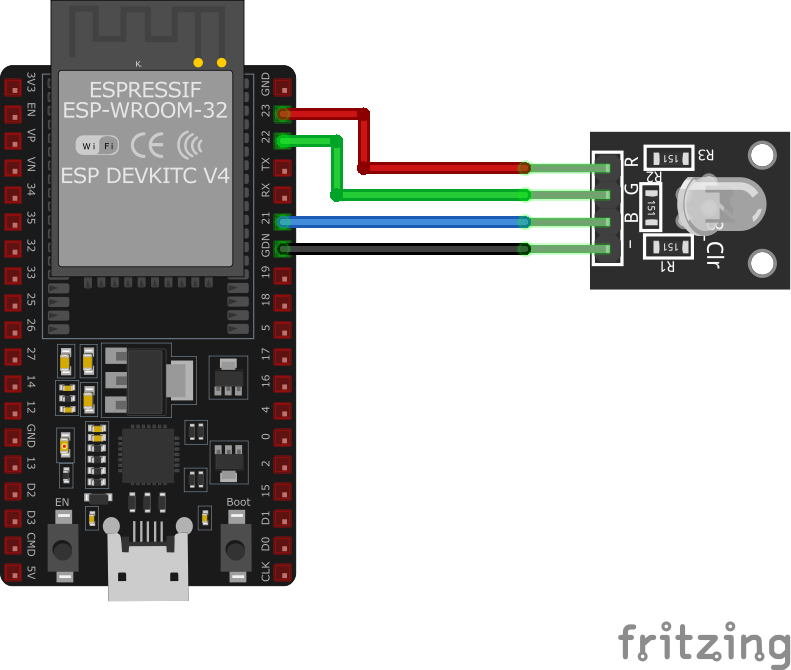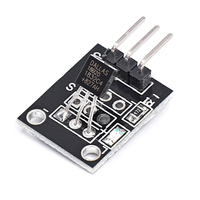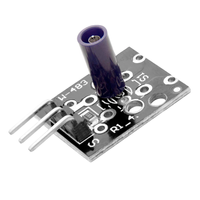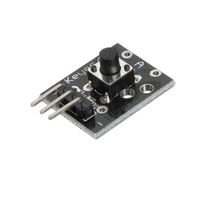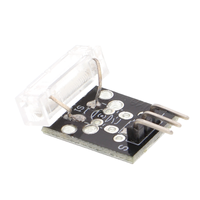ESP32 KY-016 RGB Full Color LED Module
The KY-016 is an RGB LED module that can display a wide range of colors by adjusting the brightness of its red, green, and blue LEDs. It's suitable for various applications requiring colorful visual feedback.
⬇️ Jump to Code Examples
🔗 Quick Links
🛒 KY-016 Price
ℹ️ About KY-016 RGB Full Color LED Module
The KY-016 RGB Full Color LED Module features a 5mm RGB LED with a common cathode configuration, allowing it to display up to 16.7 million colors by adjusting the intensity of its red, green, and blue components through PWM (Pulse Width Modulation). Each color channel operates at a forward current of 20mA, with forward voltages of 1.8V for red and 2.8V for green and blue. This module is ideal for projects requiring colorful visual indicators, such as mood lighting, status displays, or decorative effects.⚙️ KY-016 Sensor Technical Specifications
Below you can see the KY-016 RGB Full Color LED Module Technical Specifications. The sensor is compatible with the ESP32, operating within a voltage range suitable for microcontrollers. For precise details about its features, specifications, and usage, refer to the sensor’s datasheet.
- Protocol: PWM
- Operating Voltage: 3.3V - 5V
- Forward Voltage (Red): 1.8V
- Forward Voltage (Green, Blue): 2.8V
- Forward Current: 20mA per channel
- Dimensions: 10 x 10 x 5 mm
- Weight: 2 g
🔌 KY-016 Sensor Pinout
Below you can see the pinout for the KY-016 RGB Full Color LED Module. The VCC pin is used to supply power to the sensor, and it typically requires 3.3V or 5V (refer to the datasheet for specific voltage requirements). The GND pin is the ground connection and must be connected to the ground of your ESP32!
Pin 1 (GND):Common cathode, connect to ground.Pin 2 (R):Red LED anode.Pin 3 (G):Green LED anode.Pin 4 (B):Blue LED anode.
🧵 KY-016 Wiring with ESP32
Below you can see the wiring for the KY-016 RGB Full Color LED Module with the ESP32. Connect the VCC pin of the sensor to the 3.3V pin on the ESP32 or external power supply for power and the GND pin of the sensor to the GND pin of the ESP32. Depending on the communication protocol of the sensor (e.g., I2C, SPI, UART, or analog), connect the appropriate data and clock or signal pins to compatible GPIO pins on the ESP32, as shown below in the wiring diagram.
KY-016 Pin 1 (GND):Connect to ESP32GND.KY-016 Pin 2 (R):Connect to ESP32 GPIO pin (e.g.,GPIO25) through a 180Ω resistor.KY-016 Pin 3 (G):Connect to ESP32 GPIO pin (e.g.,GPIO26) through a 100Ω resistor.KY-016 Pin 4 (B):Connect to ESP32 GPIO pin (e.g.,GPIO27) through a 100Ω resistor.
🛠️ KY-016 RGB Full Color LED Module Troubleshooting
This guide outlines a systematic approach to troubleshoot and resolve common problems with the . Start by confirming that the hardware connections are correct, as wiring mistakes are the most frequent cause of issues. If you are sure the connections are correct, follow the below steps to debug common issues.
❌ LED Not Lighting Up
Issue: The LED does not turn on.
Solutions:
- Verify all connections are secure and correctly placed.
- Ensure appropriate current-limiting resistors are used for each LED channel.
- Check that the GPIO pins are correctly configured as outputs in the code.
🎨 Incorrect Colors Displayed
Issue: The LED displays unexpected colors.
Solutions:
- Confirm that the PWM signals are correctly set for each color channel.
- Ensure that the correct GPIO pins are assigned to the respective LED colors in the code.
- Check for any short circuits or incorrect wiring between the LED pins.
💻 Code Examples
Below you can find code examples of KY-016 RGB Full Color LED Module with ESP32 in several frameworks:
If you encounter issues while using the KY-016 RGB Full Color LED Module, check the Common Issues Troubleshooting Guide.

ESP32 KY-016 Arduino IDE Code Example
Fill in your main Arduino IDE sketch file with the following code to use the KY-016 RGB Full Color LED Module:
#define RED_PIN 10
#define GREEN_PIN 11
#define BLUE_PIN 12
void setup() {
pinMode(RED_PIN, OUTPUT);
pinMode(GREEN_PIN, OUTPUT);
pinMode(BLUE_PIN, OUTPUT);
}
void loop() {
analogWrite(RED_PIN, 255); // Red at full brightness
analogWrite(GREEN_PIN, 0); // Green off
analogWrite(BLUE_PIN, 0); // Blue off
delay(1000);
analogWrite(RED_PIN, 0);
analogWrite(GREEN_PIN, 255); // Green at full brightness
analogWrite(BLUE_PIN, 0);
delay(1000);
analogWrite(RED_PIN, 0);
analogWrite(GREEN_PIN, 0);
analogWrite(BLUE_PIN, 255); // Blue at full brightness
delay(1000);
}This Arduino code sets up the KY-016 RGB LED module by defining the pins connected to the red, green, and blue LEDs. In the loop, it cycles through red, green, and blue colors, each displayed for one second.
Connect your ESP32 to your computer via a USB cable, Ensure the correct Board and Port are selected under Tools, Click the "Upload" button in the Arduino IDE to compile and upload the code to your ESP32.
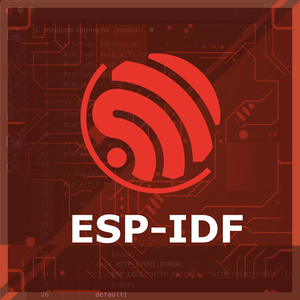
ESP32 KY-016 ESP-IDF Code ExampleExample in Espressif IoT Framework (ESP-IDF)
If you're using ESP-IDF to work with the KY-016 RGB Full Color LED Module, here's how you can set it up and read data from the sensor. Fill in this code in the main ESP-IDF file:
#include <stdio.h>
#include "freertos/FreeRTOS.h"
#include "freertos/task.h"
#include "driver/ledc.h"
#define RED_PIN GPIO_NUM_25
#define GREEN_PIN GPIO_NUM_26
#define BLUE_PIN GPIO_NUM_27
#define LEDC_TIMER LEDC_TIMER_0
#define LEDC_MODE LEDC_HIGH_SPEED_MODE
#define LEDC_CHANNEL_R LEDC_CHANNEL_0
#define LEDC_CHANNEL_G LEDC_CHANNEL_1
#define LEDC_CHANNEL_B LEDC_CHANNEL_2
void configure_led_pwm(gpio_num_t pin, ledc_channel_t channel) {
ledc_timer_config_t ledc_timer = {
.speed_mode = LEDC_MODE,
.timer_num = LEDC_TIMER,
.duty_resolution = LEDC_TIMER_8_BIT,
.freq_hz = 5000,
.clk_cfg = LEDC_AUTO_CLK
};
ledc_timer_config(&ledc_timer);
ledc_channel_config_t ledc_channel = {
.gpio_num = pin,
.speed_mode = LEDC_MODE,
.channel = channel,
.intr_type = LEDC_INTR_DISABLE,
.timer_sel = LEDC_TIMER,
.duty = 0,
.hpoint = 0
};
ledc_channel_config(&ledc_channel);
}
void set_color(uint32_t red, uint32_t green, uint32_t blue) {
ledc_set_duty(LEDC_MODE, LEDC_CHANNEL_R, red);
ledc_update_duty(LEDC_MODE, LEDC_CHANNEL_R);
ledc_set_duty(LEDC_MODE, LEDC_CHANNEL_G, green);
ledc_update_duty(LEDC_MODE, LEDC_CHANNEL_G);
ledc_set_duty(LEDC_MODE, LEDC_CHANNEL_B, blue);
ledc_update_duty(LEDC_MODE, LEDC_CHANNEL_B);
}
void app_main(void) {
configure_led_pwm(RED_PIN, LEDC_CHANNEL_R);
configure_led_pwm(GREEN_PIN, LEDC_CHANNEL_G);
configure_led_pwm(BLUE_PIN, LEDC_CHANNEL_B);
while (1) {
set_color(255, 0, 0); // Red
vTaskDelay(pdMS_TO_TICKS(1000));
set_color(0, 255, 0); // Green
vTaskDelay(pdMS_TO_TICKS(1000));
set_color(0, 0, 255); // Blue
vTaskDelay(pdMS_TO_TICKS(1000));
}
}This ESP-IDF code configures the KY-016 RGB LED module using PWM on GPIO25 (red), GPIO26 (green), and GPIO27 (blue). The configure_led_pwm() function sets up the PWM channels for each LED, while set_color() adjusts the brightness of each color. The LED cycles through red, green, and blue every second.
Update the I2C pins (I2C_MASTER_SDA_IO and I2C_MASTER_SCL_IO) to match your ESP32 hardware setup, Use idf.py build to compile the project, Use idf.py flash to upload the code to your ESP32.
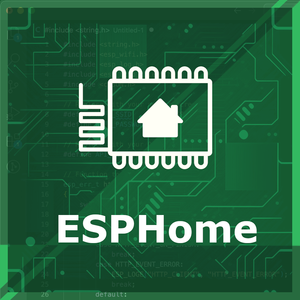
ESP32 KY-016 ESPHome Code Example
Fill in this configuration in your ESPHome YAML configuration file (example.yml) to integrate the KY-016 RGB Full Color LED Module
output:
- platform: ledc
pin: GPIO25
id: red_led
- platform: ledc
pin: GPIO26
id: green_led
- platform: ledc
pin: GPIO27
id: blue_led
light:
- platform: rgb
name: "KY-016 RGB LED"
red: red_led
green: green_led
blue: blue_led
gamma_correct: 2.8This ESPHome configuration sets up the KY-016 RGB LED module using PWM on GPIO25, GPIO26, and GPIO27. The LED's color can be adjusted through Home Assistant, allowing full RGB control.
Upload this code to your ESP32 using the ESPHome dashboard or the esphome run command.
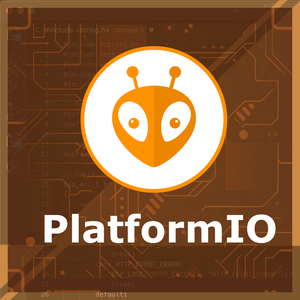
ESP32 KY-016 PlatformIO Code Example
For PlatformIO, make sure to configure the platformio.ini file with the appropriate environment and libraries, and then proceed with the code.
Configure platformio.ini
First, your platformio.ini should look like below. You might need to include some libraries as shown. Make sure to change the board to your ESP32:
[env:esp32]
platform = espressif32
board = esp32dev
framework = arduinoESP32 KY-016 PlatformIO Example Code
Write this code in your PlatformIO project under the src/main.cpp file to use the KY-016 RGB Full Color LED Module:
#include <Arduino.h>
#define RED_PIN 25
#define GREEN_PIN 26
#define BLUE_PIN 27
void setup() {
pinMode(RED_PIN, OUTPUT);
pinMode(GREEN_PIN, OUTPUT);
pinMode(BLUE_PIN, OUTPUT);
}
void loop() {
analogWrite(RED_PIN, 255);
analogWrite(GREEN_PIN, 0);
analogWrite(BLUE_PIN, 0);
delay(1000);
analogWrite(RED_PIN, 0);
analogWrite(GREEN_PIN, 255);
analogWrite(BLUE_PIN, 0);
delay(1000);
analogWrite(RED_PIN, 0);
analogWrite(GREEN_PIN, 0);
analogWrite(BLUE_PIN, 255);
delay(1000);
}This PlatformIO code configures the KY-016 RGB LED module on GPIO25, GPIO26, and GPIO27. The LED cycles through red, green, and blue every second using PWM signals.
Upload the code to your ESP32 using the PlatformIO "Upload" button in your IDE or the pio run --target upload command.
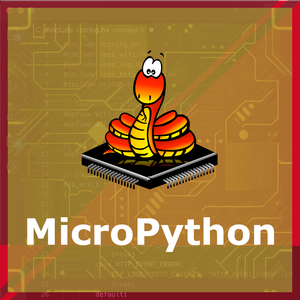
ESP32 KY-016 MicroPython Code Example
Fill in this script in your MicroPython main.py file (main.py) to integrate the KY-016 RGB Full Color LED Module with your ESP32.
import machine
import time
RED_PIN = machine.PWM(machine.Pin(25), freq=1000)
GREEN_PIN = machine.PWM(machine.Pin(26), freq=1000)
BLUE_PIN = machine.PWM(machine.Pin(27), freq=1000)
def set_color(r, g, b):
RED_PIN.duty(r)
GREEN_PIN.duty(g)
BLUE_PIN.duty(b)
while True:
set_color(1023, 0, 0) # Red
time.sleep(1)
set_color(0, 1023, 0) # Green
time.sleep(1)
set_color(0, 0, 1023) # Blue
time.sleep(1)This MicroPython script configures GPIO25, GPIO26, and GPIO27 as PWM outputs for the KY-016 RGB LED module. The set_color() function controls the brightness of each LED channel, cycling through red, green, and blue every second.
Upload this code to your ESP32 using a MicroPython-compatible IDE, such as Thonny, uPyCraft, or tools like ampy.
Conclusion
We went through technical specifications of KY-016 RGB Full Color LED Module, its pinout, connection with ESP32 and KY-016 RGB Full Color LED Module code examples with Arduino IDE, ESP-IDF, ESPHome and PlatformIO.

